Here are the number of new confirmed COVID-19 cases per day, here in the province of Ontario:
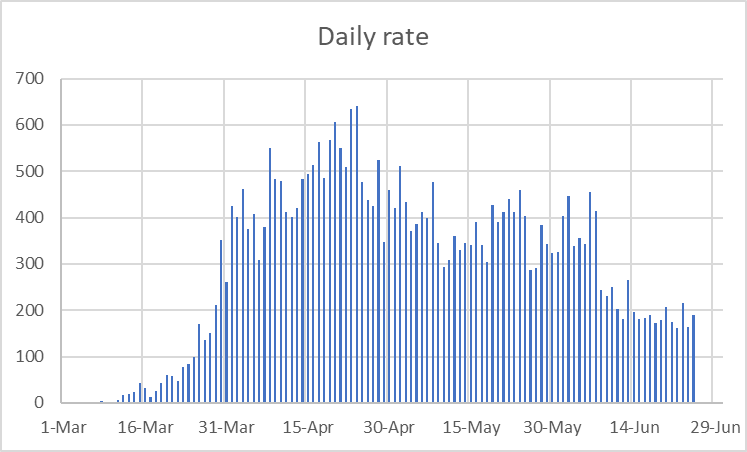 In the whole of Canada:
In the whole of Canada:
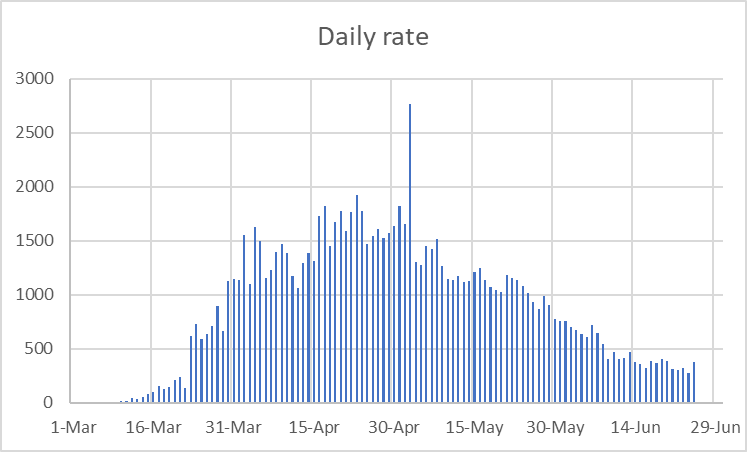
In the great United States:
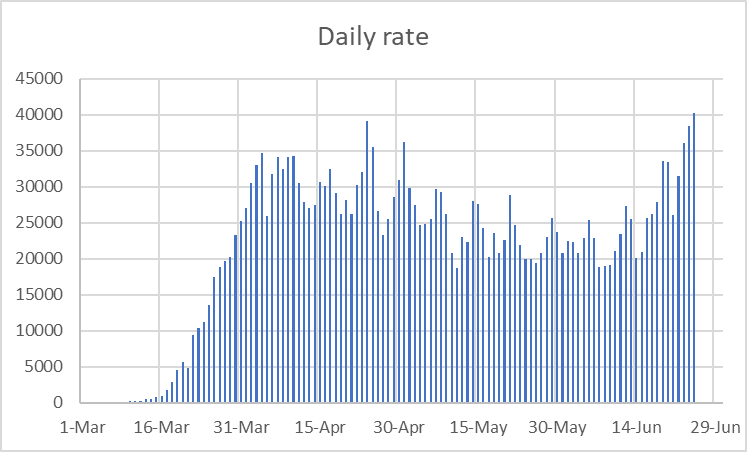
And in the entire world:
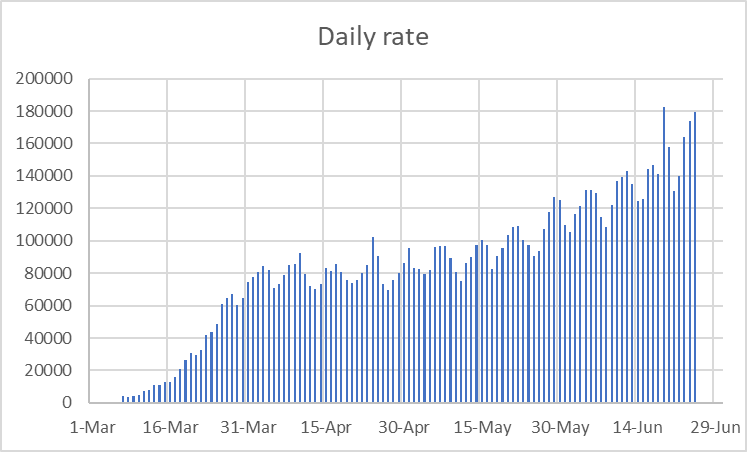
The plots tell the story. I don’t think that there is anything that I can add.
Here are the number of new confirmed COVID-19 cases per day, here in the province of Ontario:
 In the whole of Canada:
In the whole of Canada:

In the great United States:

And in the entire world:

The plots tell the story. I don’t think that there is anything that I can add.
Dame Vera Lynn is no longer with us.
She was 103 years old.
In response to the COVID-19 pandemic, the Parliament of Hungary granted Viktor Orban’s government extraordinary powers to rule by decree. Opponents likened this to the infamous “enabling act” that marked the end of the Weimar Republic in 1933.
In response, Mr. Orban and his supporters argued that the government has no intention of abusing these powers, and that Mr. Orban should be judged by how he relinquishes these extraordinary powers once the crisis is over.

So here it is: Parliament just voted to end the state of emergency and requested the government to take the necessary steps to return to normalcy. So far so good. The corresponding act of Parliament is short and sweet, and to the point. The legal part of the text is only four terse clauses. In my translation:
1. The Legislature requests the government to end, in accordance with section 54, paragraph 3 of the Constitution, the state of emergency that was declared in government decree 40/2020 (March 11) (henceforth: the state of emergency).
2. The act of Parliament concerning measures against the coronavirus, Bill 12 (2020), is no longer in force.
3. (1) The present act – with the exceptions defined in paragraph (2) – shall be considered in force the day after it is proclaimed.
(2) Clauses 2 and 4 shall be considered in force when the state of emergency ends.
(3) The calendar day when clauses 2 and 4 shall be considered in force will be decided by the Prime Minister as soon as the date is known, by immediately proclaiming the date in the Hungarian Gazette.
4. Clause 2 of this bill, in accordance with section 29, paragraph 3; section 2, paragraph 1; section 24, paragraph 9, section 31, paragraphy 3; section 35, paragrapha 1; and section 54, paragraph 4, is considered fundamental.
All looks kosher, right?
But just in case you are still paying attention… there was also a second bill on the table. It has an unassuming title: “About the rules of transition concerning the end of the state of emergency and health preparedness”. Seems eminently reasonable, since under the state of emergency, the government has taken many steps, all of which must be reconciled with the system of laws and regulations.
And there is a lot. This supplementary bill is not four pages. It is 247 (two hundred forty seven) pages in PDF form. Yikes!
And on page 135, we read clause 97:
97. Changes to Bill 128 of 2011 concerning emergency preparedness and modifications of related laws
§339 Section 5 of Bill 128 of 2011 concerning emergency preparedness and modifications of related laws will be amended by the following subclause 24/A:
“24/A Emergency acts of government in case of a state of emergency concerning a human epidemic causing mass rates of infection”
§51/A. (1) The Government, in order to prevent, or mitigate the consequences of, a human epidemic that causes mass rates of infection, threatening lives and property, in order to protect the health and life of citizens of Hungary in a declared state of emergency – in addition to the emergency measures and rules described in subclauses 21-24 – in order to guarantee the lives, health, personal security, security of property, and legal protection of citizens and the stability of the national economy, may, by decree, suspend certain laws, deviate from existing laws and make other extraordinary decisions.
(2) The Government may practice the authority prescribed in paragraph (1) – to the necessary extent, in proportion with the desired outcome – in order to prevent, deal with, and eliminate an epidemic, and furthermore, to prevent or avoid such an outbreak.
There you have it. There are many other clauses concerning other laws, and most seem quite reasonable and appropriate considering the circumstances. But this one?
I highlighted the problem text in red. The law gives the government extraordinary powers. But, though the words seem reassuring on the surface, it offers no checks and balances concerning any justification of invoking these powers and the extent to which they are practiced. In the right hands, these are powers that can be used wisely in case of another pandemic or a resurgence of COVID-19, and I am sure Mr. Orban’s supporters believe that this is precisely how the government will use these powers (if at all). But opponents of Mr. Orban are concerned, not without grounds, about the lack of checks and balances and the very real possibility that these powers can go unchecked in the wrong hands.
In short, this is precisely what many feared: That though the state of emergency is lifted, a backdoor remains, a means for Mr. Orban’s government to have its cake and eat it, too, relinquish its extraordinary powers yet keeping them at the same time.
In the end, it of course all depends on how the law is put into practice. But for now, my conclusion is that the concerns of Mr. Orban’s opposition are not unfounded.
I just happened upon this 30-year old John Cleese sketch, where else? On John Cleese’s own Twitter feed, of course.
What can I say? Just perfect. As appropriate today as it was three decades ago, perhaps even more so.
In 1889, a story by Jules Verne (believed to have been written actually by his son, Michel Verne) was published in the American magazine Forum under the title, “In the Year 2889“.
In it, among other things, Verne envisions video conferencing.
Verne’s story was illustrated by George Roux, who is best known for his numerous illustrations for Verne’s science-fiction novels. I suspect that this particular picture was made in 1889 or 1890 (when Verne’s story, which appeared originally in English, was republished in France.)
I find this image mind-boggling. That 130 years ago, back in the 19th century, someone was able to envision… well, something that, for all intents and purposes, looks pretty much like what many of us are doing today.
In case anyone doubted that modern birds are descendants of dinosaurs, here is a reminder: the shoebill.
These amazing creatures are apparently quite docile with humans, but eat baby crocodiles for lunch, which they kill by decapitating them.
They really look like survivors of the K-T asteroid impact. They are… I think they are beautiful.
Amidst all the tension that has been unleashed in the United States, there is this small ray of hope.
A black flight attendant on a Southwest flight initiated a conversation with a white passenger, who was reading the book White Fragility: Why It’s So Hard for White People to Talk About Racism, by Robin DiAngelo.
The white passenger’s remark, “It’s our fault. We have to start these conversations,” caught her by surprise. A short conversation followed. Then the big revelation: The unassuming gentleman happened to be Doug Parker, CEO of American Airlines.
I can already hear some of my friends objecting: “It’s not our fault!” Do not misconstrue Parker’s words (perhaps they weren’t even quoted verbatim.) He of course didn’t mean, I am sure, that every white person must bear personal responsibility for every vile act of racism that happens in America or elsewhere.
Rather, what I read into those words is an acknowledgement of a simple reality: In an unequal relationship, the dominant party has the power to make change for the better. In America, this means whites.
The fact that the CEO of a company as large as American Airlines recognizes this is, well, a ray of hope. As is the fact that he traveled, unassumingly, as an ordinary economy passenger on a competitor’s flight. As rising inequality between the super-wealthy and the stagnating middle class plagues Western societies, the US in particular, as disadvantaged minorities fall even further behind, it is nice to know that at least some folks in positions of power recognize that their wealth and status also come with a huge responsibility. Especially if the nice thoughts are also followed by deeds.
I don’t always like commercial publishers. Some of their textbooks are prohibitively expensive, yet often lacking in quality. (One persistent exception is Dover Publications, who published some of the best textbooks I own, as low-cost paperbacks.)
Last night, however, I was very pleasantly surprised by Springer, who made several hundred textbooks across a range of disciplines available for free, on account of COVID-19.
I did not get greedy. I didn’t download titles indiscriminately. But I did find several titles that are of interest to me, and I gladly took advantage of this opportunity.
Thank you, Springer.
Still playing with some COVID-19 maps, so here is another one: This one ranks countries by the number of COVID-19 cases per 1,000 square kilometers.
What’s the point, you might ask? Well, when there are lots of people confined to a small area, even a few cases can mean trouble; in contrast, when you have many cases but spread over half a continent, you may never come across a single infected person in your travels.

Again, the color legend remains a little whacky; it is logarithmic, but I don’t know how to convince this R package to display it nicely.
The numbers are pretty high. It goes without saying that densely populated microstates like Monaco win the contest, but then there is Qatar (3494), Belgium (1866), the Netherlands (1324), the UK (1051)… numbers that are way too high. For comparison, the USA is at 180, Hungary at 41, Russia at 20 (no surprise there), China at 9 (!), and so is Canada.
Maps that show the spread and mortality rate of COVID-19 are worrisome, to say the least.
So here is something slightly more encouraging: the day-to-day growth rate of COVID-19 infections, in the world, the United States, Canada, and the province of Ontario where I live.
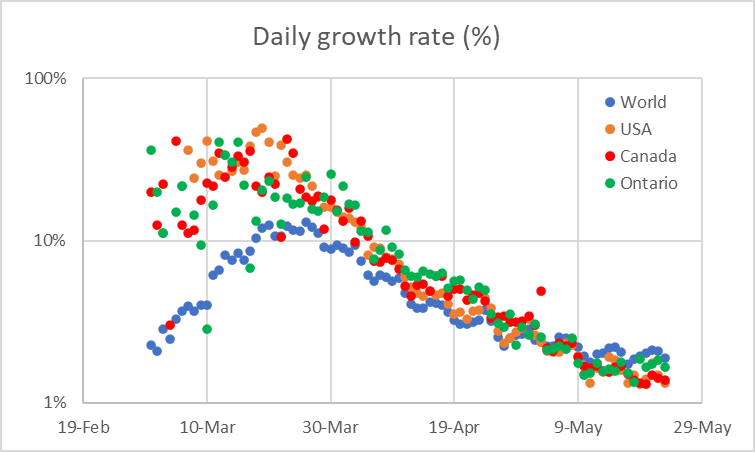
What this plot shows is that the growth rate has been consistently and steadily decreasing (note that the vertical axis is logarithmic). Furthermore, the overall behavior of the worldwide, US, and Canadian plots is remarkable similar.
Of course this plot is also a reflection of the fact that the cumulative number of cases increases, so even if the number of new cases remains steady, the growth rate will indeed decrease. Nonetheless, it demonstrates that at least for now, the pandemic’s exponential spread has been arrested. This can, of course, change for the worse quite dramatically if we lose our collective patience and start relaxing too soon.
I suppose the most important thing to know about COVID-19 is not so much the total number of cases or deaths, but the number of cases or deaths per million people. A number like 1,000 deaths is huge in a country of one million, a drop in the bucket in a country like India or China.
In that vein, I produced two maps using my rather rusty R programming skills. I am sure I could have done a better job labeling the legend, but there is only so much time I wanted to spend on this. The color bar legend is logarithmic between its two end values.
First, the cumulative number of cases per million people (May 22 data):
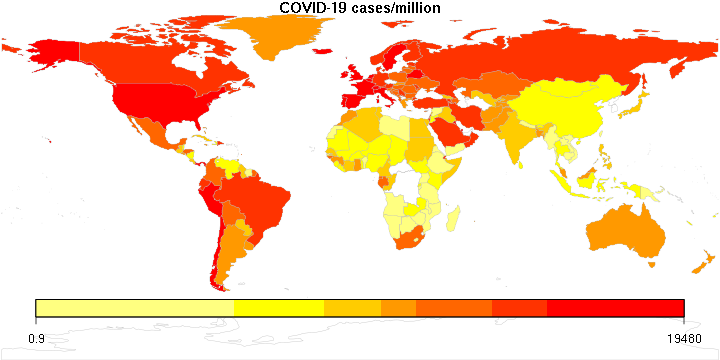
Next, deaths per million:
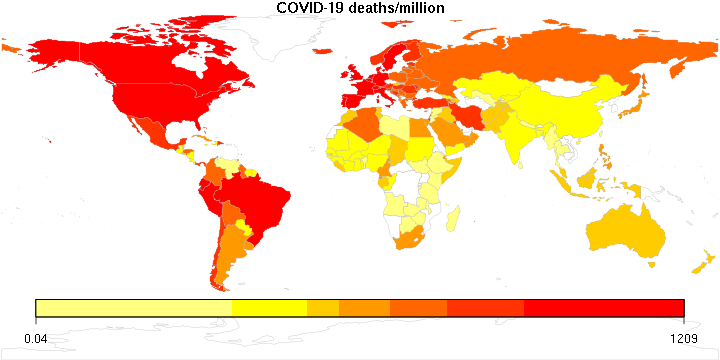
Not a pretty picture. It appears that the countries that are the most disproportionately affected (or the most likely to offer accurate reports?) are in Europe (including Russia), North and South America and the Middle East.
But now, here is perhaps the scariest map of all:
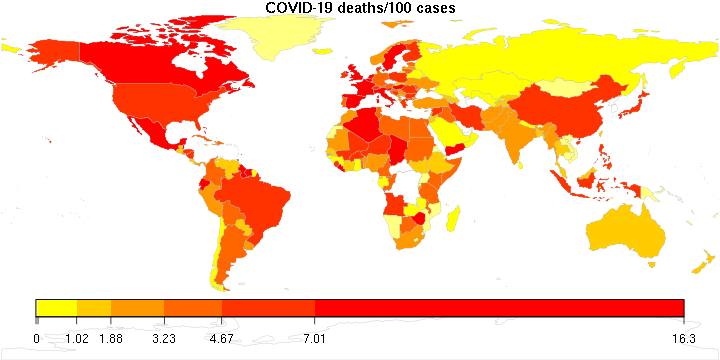
Yes, in many countries more than 10% of the confirmed cases result in death. The global average is 6.4 per 100 confirmed cases. The fact that COVID-19 is deadly in countries with underdeveloped health care systems is perhaps understandable, but the fact that the reddest parts of the map are places with the most sophisticated health care systems in the world is food for thought.
I am one of the maintainers of the Maxima computer algebra system. Maxima’s origins date back to the 1960s, when I was still in kindergarten. I feel very privileged that I can participate in the continuing development of one of the oldest continuously maintained software system in wide use.
It has been a while since I last dug deep into the core of the Maxima system. My LISP skills are admittedly a bit rusty. But a recent change to a core Maxima capability, its ability to create Taylor-series expansions of expressions, broke an important feature of Maxima’s tensor algebra packages, so it needed fixing.
The fix doesn’t amount to much, just a few lines of code:
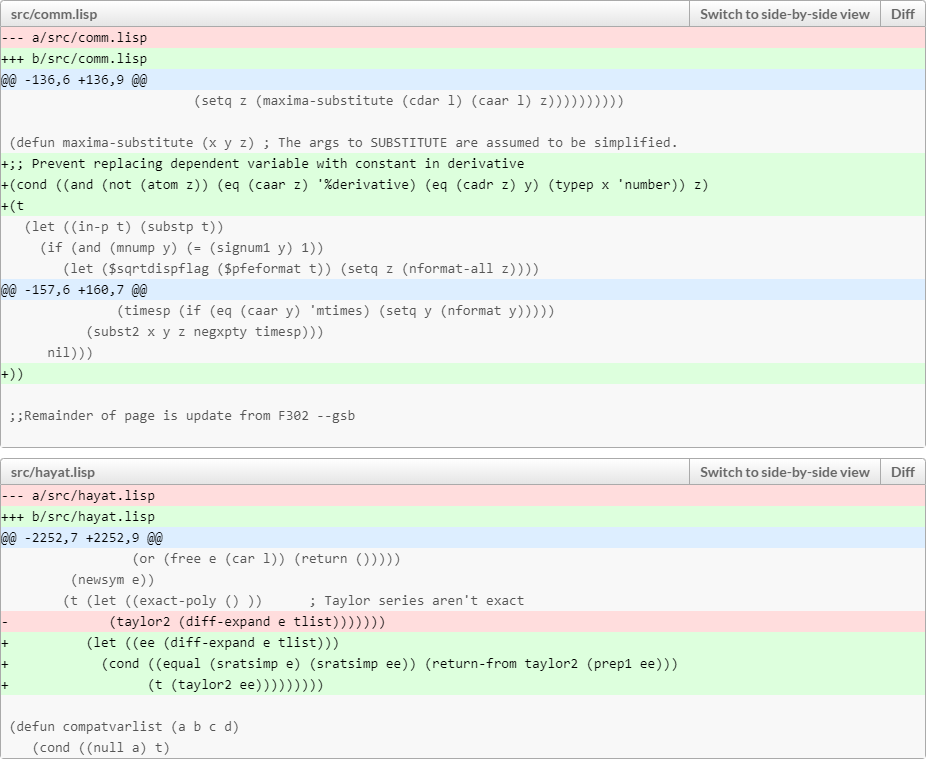
It did take more than a few minutes though to find the right (I hope) way to implement this fix.
Even so, I had fun. This is the kind of programming that I really, really enjoy doing. Sadly, it’s not the kind of programming for which people usually pay you Big Bucks… Oh well. The fun alone was worth it.
One of the most fortunate moments in my life occurred in the fall of 2005, when I first bumped into John Moffat, a physicist from The Perimeter Institute in Waterloo, Ontario, Canada, when we both attended the first Pioneer Anomaly conference hosted by the International Space Science Institute in Bern, Switzerland.
This chance encounter turned into a 15-year collaboration and friendship. It was, to me, immensely beneficial: I learned a lot from John who, in his long professional career, has met nearly every one of the giants of 20th century physics, even as he made his own considerable contributions to diverse areas ranging from particle physics to gravitation.
In the past decade, John also wrote a few books for a general audience. His latest, The Shadow of the Black Hole, is about to be published; it can already be preordered on Amazon. In their reviews, Greg Landsberg (CERN), Michael Landry (LIGO Hanford) and Neil Cornish (eXtreme Gravity Institute) praise the book. As I was one of John’s early proofreaders, I figured I’ll add my own.
John began working on this manuscript shortly after the announcement by the LIGO project of the first unambiguous direct detection of gravitational waves from a distant cosmic event. This was a momentous discovery, opening a new chapter in the history of astronomy, while at the same time confirming a fundamental prediction of Einstein’s general relativity. Meanwhile, the physics world was waiting with bated breath for another result: the Event Horizon Telescope collaboration’s attempt to image, using a worldwide network of radio telescopes, either the supermassive black hole near the center of our own Milky Way, or the much larger supermassive black hole near the center of the nearby galaxy M87.
Bookended by these two historic discoveries, John’s narrative invites the reader on a journey to understand the nature of black holes, these most enigmatic objects in our universe. The adventure begins in 1784, when the Reverend John Michell, a Cambridge professor, speculated about stars so massive and compact that even light would not be able to escape from its surface. The story progresses to the 20th century, the prediction of black holes by general relativity, and the strange, often counterintuitive results that arise when our knowledge of thermodynamics and quantum physics is applied to these objects. After a brief detour into the realm of science-fiction, John’s account returns to the hard reality of observational science, as he explains how gravitational waves can be detected and how they fit into both the standard theory of gravitation and its proposed extensions or modifications. Finally, John moves on to discuss how the Event Horizon Telescope works and how it was able to create, for the very first time, an actual image of the black hole’s shadow, cast against the “light” (radio waves) from its accretion disk.
John’s writing is entertaining, informative, and a delight to follow as he accompanies the reader on this fantastic journey. True, I am not an unbiased critic. But don’t just take my word for it; read those reviews I mentioned at the beginning of this post, by preeminent physicists. In any case, I wholeheartedly recommend The Shadow of the Black Hole, along with John’s earlier books, to anyone with an interest in physics, especially the physics of black holes.
Heaven knows why I sometimes get confused by the simplest things.
In this case, the conversion between two commonly used cosmological coordinate systems: Comoving coordinates vs. coordinates that are, well, not comoving, in which cosmic expansion is ascribed to time dilation effects instead.
In the standard coordinates that are used to describe the homogeneous, isotropic universe of the Friedmann–Lemaître–Robertson–Walker (FLRW) metric, the metric is given by
$$ds^2=dt^2-a^2dR^2,$$
where \(a=a(t)\) is a function of the time coordinate, and \(R\) represents the triplet of spatial coordinates: e.g., \(dR^2=dx^2+dy^2+dz^2.\)
I want to transform this using \(R’=aR,\) i.e., transform away the time-dependent coefficient in front of the spatial term in the metric. The confusion comes because for some reason, I always manage to convince myself that I also have to make the simultaneous replacement \(t’=a^{-1}dt.\)
I do not. This is nonsense. I just need to introduce \(dR’\). The rest then presents itself automatically:
$$\begin{align*}
R’&=aR,\\
dR&=d(a^{-1}R’)=-a^{-2}\dot{a}R’dt+a^{-1}dR’,\\
ds^2&=dt^2-a^2[-a^{-2}\dot{a}R’dt+a^{-1}dR’]^2\\
&=(1-a^{-2}\dot{a}^2{R’}^2)dt^2+2a^{-1}\dot{a}R’dtdR’-d{R’}^2\\
&=(1-H^2{R’}^2)dt^2+2HR’dtdR’-d{R’}^2,
\end{align*}$$
where \(H=\dot{a}/a\) as usual.
OK, now that I recorded this here in my blog for posterity, perhaps the next time I need it, I’ll remember where to find it. For instance, the next time I manage to stumble upon one of my old Quora answers that, for five and a half years, advertised my stupidity to the world by presenting an incorrect answer on this topic.
This, incidentally, would serve as a suitable coordinate system representing the reference frame of an observer at the origin. It also demonstrates that such an observer sees an apparent horizon, the cosmological horizon, given by \(1-H^2{R’}^2=0,\), i.e., \(R’=H^{-1},\) the distance characterized by the inverse of the Hubble parameter.
So here I am, reading about some trivial yet not-so-trivial probability distributions.
Let’s start with the uniform distribution. Easy-peasy, isn’t it: a random number, between 0 and 1, with an equal probability assigned to any value within this range.
So… what happens if I take two such random numbers and add them? Why, I get a random number between 0 and 2 of course. But the probability distribution will no longer be uniform. There are more ways to get a value in the vicinity of 1 than near 0 or 2.
And what happens if I add three such random numbers? Or four? And so on?
The statistics of this result are captured by the Irwin-Hall distribution, defined as
$$f_{\rm IH}(x,n)=\dfrac{1}{2(n-1)!}\sum\limits_{k=1}^n(-1)^k\begin{pmatrix}n\\k\end{pmatrix}(x-k)^{n-1}{\rm sgn}(x-k).$$
OK, so that’s what happens when we add these uniformly generated random values. What happens when we average them? This, in turn, is captured by the Bates distribution, which, unsurprisingly, is just the Irwin-Hall distribution, scaled by the factor \(n\):
$$f_{\rm B}(x,n)=\dfrac{n}{2(n-1)!}\sum\limits_{k=1}^n(-1)^k\begin{pmatrix}n\\k\end{pmatrix}(nx-k)^{n-1}{\rm sgn}(nx-k).$$
How about that.
For what it’s worth, here is the Maxima script to generate the Irwin-Hall plot:
fI(x,n):=1/2/(n-1)!*sum((-1)^k*n!/k!/(n-k)!*(x-k)^(n-1)*signum(x-k),k,0,n);
plot2d([fI(x,1),fI(x,2),fI(x,4),fI(x,8),fI(x,16)],[x,-2,18],[box,false],
[legend,"n=1","n=2","n=4","n=8","n=16"],[y,-0.1,1.1]);
And this one for the Bates plot:
fB(x,n):=n/2/(n-1)!*sum((-1)^k*n!/k!/(n-k)!*(n*x-k)^(n-1)*signum(n*x-k),k,0,n);
plot2d([fB(x,1),fB(x,2),fB(x,4),fB(x,8),fB(x,16)],[x,-0.1,1.1],[box,false],
[legend,"n=1","n=2","n=4","n=8","n=16"],[y,-0.1,5.9]);
Yes, I am still a little bit of a math geek at heart.
My lovely wife, Ildiko, woke up from a dream and asked: If you have a flower with 7 petals and two colors, how many ways can you color the petals of that flower?

Intriguing, isn’t it.
Such a flower shape obviously has rotational symmetry. Just because the flower is rotated by several times a seventh of a revolution, the resulting pattern should not be counted as distinct. So it is not simply calculating what number theorists call the \(n\)-tuple. It is something more subtle.
We can, of course, start counting the possibilities the brute force way. It’s not that difficult for a smaller number of petals, but it does get a little confusing at 6. At 7 petals, it is still something that can be done, but the use of paper-and-pencil is strongly recommended.
So what about the more general case? What if I have \(n\) petals and \(k\) colors?
Neither of us could easily deduce an answer, so I went to search the available online literature. For a while, other than finding some interesting posts about cyclic, or circular permutations, I was mostly unsuccessful. In fact, I began to wonder if this one was perhaps one of those embarrassing little problems in combinatorial mathematics that has no known solution and about which the literature remains strangely quiet.
But then I had another idea: By this time, we both calculated the sequence, 2, 3, 4, 6, 8, 14, 20, which is the number of ways flowers with 1, 2, …, 7 petals can be colored using only two colors. Surely, this sequence is known to Google?
Indeed it is. It turns out to be a well-known sequence in the online encyclopedia of integer sequences, A000031. Now I was getting somewhere! What was especially helpful is that the encyclopedia mentioned necklaces. So that’s what this problem set is called! Finding the Mathworld page on necklaces was now easy, along with the corresponding Wikipedia page. I also found an attempt, valiant though only half-successful if anyone is interested in my opinion, to explain the intuition behind this known result:
$$N_k(n)=\frac{1}{n}\sum_{d|n}\phi(d)k^{n/d},$$
where the summation is over all the divisors of \(n\), and \(\phi(d)\) is Euler’s totient function, the number of integers between \(1\) and \(d\) that are relative prime to \(d\).
Evil stuff if you asked me. Much as I always liked mathematics, number theory was not my favorite.
In the case of odd primes, such as the number 7 that occurred in Ildiko’s dream, and only two colors, there is, however, a simplified form:
$$N_2(n)=\frac{2^{n-1}-1}{n}+2^{(n-1)/2}+1.$$
Unfortunately, this form is for “free necklaces”, which treats mirror images as equivalent. For \(n<6\) it makes no difference, but substituting \(n=7\), we get 18, not 20.
Finally, a closely related sequence, A000029, characterizes necklaces that can be turned over, that is to say, the case where we do not count mirror images separately.
Oh, this was fun. It’s not like I didn’t have anything useful to do with my time, but it was nonetheless a delightful distraction. And a good thing to chat about while we were eating a wonderful lunch that Ildiko prepared today.
The other day, I ran across a question on Quora asking why Einstein didn’t support his country, Germany, during the Second World War. Thinking about this question reminded me of an old Star Trek episode and one of the root concepts (or, at least, my reading of it) of the Abrahamic family of religions.
In answering the question, I pointed out the difference between supporting a country vs. supporting a regime. I argued that Einstein, though not even a citizen of Germany at the time (he gave up German citizenship after Hitler’s rise to power in 1933, and became a naturalized US citizen in 1940), did, in fact, support his country of birth, precisely by the act of following his conscience and opposing the despotic, murderous Nazi regime.
And that takes me to the Star Trek episode Bread and Circuses from 1968. In this episode, the USS Enterprise encounters a planet governed by a regime not unlike the Roman Empire, but with 20th century technology, broadcasting gladiatorial matches by analog television. In due course, the crew of the Enterprise gets into trouble and link up with a group of rebellious Sun-worshippers. When at the end of the episode, after the conflict is resolved and the good guys prevail as usual, Spock expresses surprise over the fact that such a primitive religion could have survived on this planet into its modern era, Uhura corrects him by clarifying that they were, in fact, worshippers of the son of God. In other words, this planet’s version of early Christianity arrived two thousand years later than on the Earth.

Christianity borrows its creation mythology from Judaism, including the notion of the Garden of Eden and the Tree of Knowledge, the fruit of which let Adam and Eve understand the difference between good and evil. In my reading, this is what it really means when the Bible proclaims that humans are created in God’s image: that just like God, humans are free agents with a conscience, capable of acting independently, not robots blindly executing a predetermined divine script. They even have the capacity to act against God’s will.
Think about this, just what a revolutionary, what a deeply subversive concept this really is even today, never mind ancient times. The Book of Genesis is probably about 3,000 years old if not older. Egypt, in its third intermediate period, was ruled by pharaohs, seen as intermediaries between gods and ordinary people, whose words must be obeyed. Whether or not the Egyptian captivity happened (there do appear to be reasons to doubt), it’s no wonder Egypt’s rulers didn’t look kindly upon these pesky Jews and their subversive religion that claimed that it is more important to listen to your conscience than to blindly follow the orders of your divine ruler.
Despots can claim whatever they want: They can claim to represent the state, they can even claim to be the earthly representative of a divine power, like the pharaohs of old, but you have something over which they have no power: your conscience, which allows you to defy the will of any ruler, even God’s will, just as Adam and Eve have done back in the Garden of Eden.
And this is precisely what Einstein did when he lent his support, for instance, to Leo Szilard’s letter to Roosevelt that arguably launched the Manhattan project: Instead of slavishly following a despot claiming to represent the country of his birth, he listened to his conscience.
Just as things are beginning to look ever so slightly hopeful with infection rates at least stabilizing, conspiracy theorists are now having a field day.
In case you are wondering, we “know” that SARS-CoV-2 was manufactured (or at least released) by that Wuhan “bioweapons” lab, as its intended purpose was to weaken China’s strategic opponents, in particular the US military, so that they can mess with Taiwan. And even more blatantly, they did so using in part funding from the United States, according to information that was “just revealed”. And all in the service of some demonic Chinese plot to achieve some nefarious goal, such as the subjugation of the renegade province of Taiwan.
Like all good conspiracy theories, this nonsense is also based on a carefully picked set of selected facts. So much so that it reminds me of those old Soviet-era Radio Yerevan jokes.
Meanwhile in the real world…
None of this matters to conspiracy theorists, of course. If they want to believe that it was all some evil Chinese plot, they will do so, damn the evidence. (Sadly, I think it is a safe bet that they get at least some help from Russian troll farms. Unfortunately Putin’s regime has not stopped spreading disinformation about health care, epidemics, pandemics, vaccines and now, the origins of COVID-19.)
So to all the conspiracy theory fans out there, please keep this in mind: Conspiracy theories serve a single purpose. They turn us: individuals or entire nations, against each other. They are the means to sow discord. Just when the world has to act in unison more than ever, they pull us apart. Conspiracy theories are weapons: dangerous in the wrong hands even when used unintentionally, but deadly if used purposefully.
Please… listen to the actual science. Don’t believe every piece of garbage you hear.
I haven’t blogged in two weeks. In my excuse, I was rather busy. The good kind of busy, that is, busy with paying work, busy with scientific research, not busy with illness or anything on that front.
Anyhow, even though I haven’t blogged, I’ve been keeping track of the numbers. And for the past few days, a ray of hope began to emerge.
To make a long story short, there are significant signs that mitigation measures are working. Here, this chart shows the doubling rate of COVID-19 infections worldwide:
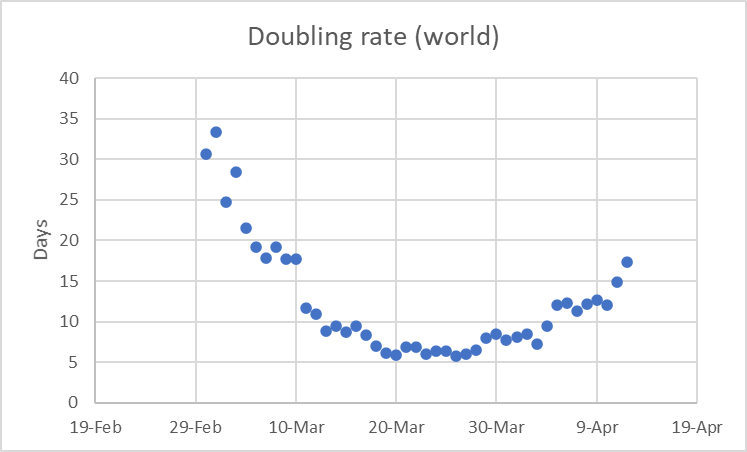
Infection rates doubled every 5-6 days back in late March; now, the doubling rate is over 15 days and rapidly rising.
Perhaps the world data are manipulated. But then, here is the doubling rate for Canada. The data are much more noisy (the population is much smaller, so this is to be expected) but the similar trend is unmistakable:
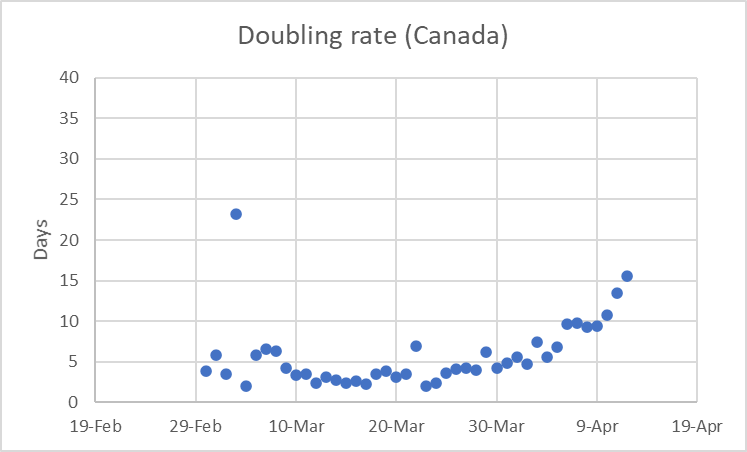
But there is another sign that things just might be working. I’ve been following US data in more detail, and lately, the simple SIR model’s predictions began to match the data rather well. If the model is to be believed, we may not be out of the woods quite yet, but we may be surprisingly close:
What a difference a few weeks make: Back in late March, the same model predicted catastrophic numbers. Now, it seems to tell us that we are mere weeks away from life gradually beginning to return to normal.
I dare not believe it just yet, but it is a ray of hope.